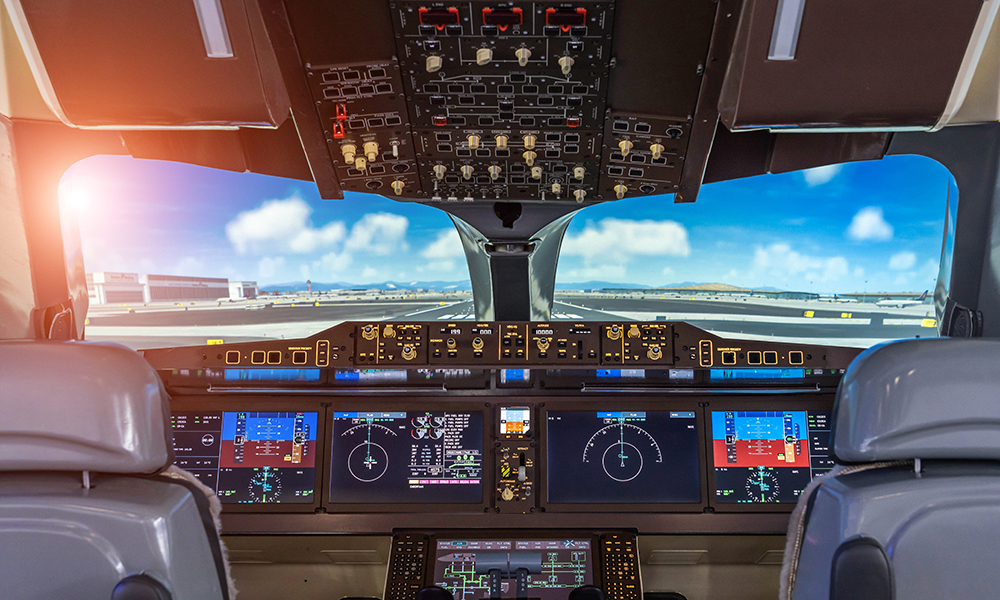
全球部分最大的飛機制造商似乎相信,通過引入新技術和提升自動化水平,能夠減少駕駛艙的飛行員人數。對他們來說,這已不再是一個是否可行的問題,而僅僅是時間問題。盡管外界誤認為飛機在很大程度上會自動飛行,但事實并非如此。商業航班上的自動駕駛系統僅作為輔助工具,并不能完全取代飛行員的訓練和經驗。隨著這些制造商推動駕駛艙技術革新,有一條紅線是絕對不能跨越的:任何企圖剝奪飛行員控制權的努力。
在我們為繁忙的假日旅游季做準備時,航空業對乘客安全的至高承諾不容置疑。這就是為何在那些“糟糕的主意”——比如將飛行員排除在駕駛艙之外——變得根深蒂固之前發出警告至關重要。遺憾的是,這并非一個荒誕不經、遙不可及的想法;飛機制造商正在積極推進,力圖盡早實現這一目標。歐洲制造商達索(Dassault)和空中客車(Airbus)已經在設計中融入了新技術,他們表示,這些新技術將允許一名飛行員獨立操控商用飛機。
長期以來,飛行員一直擁抱技術,以提升他們作為團隊管理和應對緊急情況及異常事件的能力,從而增強飛行安全。但是,在商業航班上,依靠技術(無論多么先進)來完全承擔一名或兩名飛行員的角色未免太過頭了。作為一名擁有28年飛行經驗的飛行員,我可以告訴大家,即使是在配備最新設備的新型客機駕駛艙中,技術也會出現故障。對自主系統的信任增加會導致對其過度依賴,而這些系統無疑可能會出現故障或被黑客攻擊。
近期發生的幾起引人注目的事件凸顯了每次飛行都必須配備兩名精力充沛、訓練有素的合格飛行員的重要性。去年,在奧斯汀上空的濃霧中,聯邦快遞(FedEx Express)波音767飛機上的兩名飛行員迅速采取行動,成功避免了與西南航空公司(Southwest)波音737飛機相撞,從而防止了一場潛在災難的發生。同樣,今年早些時候,阿拉斯加航空公司(Alaska Airlines)1282號航班的艙門塞爆裂,導致飛機迅速減壓,在駕駛艙中的兩名飛行員成功操控飛機安全著陸。美國國家運輸安全委員會(National Transportation Safety Board)主席珍妮弗·霍曼迪(Jennifer Homendy)將這一壯舉譽為“英勇之舉”。
在這兩起事件以及數百起類似事件中,并非技術本身防止災難發生,而是兩名飛行員組成的團隊齊心協力,將他們的專業知識、警覺性和快速分析多種因素的能力結合起來,做出決策,從而確保飛行安全。盡管這些事件背后的原因多種多樣,但這一關鍵的安全機制正如設計預期那樣發揮了作用。令人難以置信的是,盡管有這樣的故事和其他無數未登上頭條的飛行中出現的計算機或機械故障,但一些制造商仍在不斷推進,試圖用自動化技術取代飛行員。這些事件應該警示我們,飛行員在飛行中的關鍵時刻表現出了至關重要的、不可替代的識別和反應能力,這也是我在致空中客車公司首席執行官紀堯姆·傅里(Guillaume Faury)的聯名信中所強調的信息。
技術在減少工作量和提高意識方面有著巨大潛力,同時還能為乘客創造更安全的飛行環境。然而,在推動自動化的同時,減少飛行員人數,甚至實現零人類飛行員,并非出于利用技術提升安全性的考量,而是為了增加盈利。絕大多數乘坐飛機的公眾都反對將飛行員從駕駛艙中撤走。我所代表的國際航空公司飛行員聯合會委托進行的一項調查發現,近80%的美國成年人表示,遠程操控的飛機會降低他們的飛行安全感,而且絕大多數人表示,如果駕駛艙內不配備兩名飛行員,他們將永遠無法安心。國際運輸工人聯合會(International Transport Workers' Federation)的另一項調查也發現,全球人士強烈反對全自主飛行,76%的受訪者表示,如果飛機上沒有配備飛行員,他們會感到不自在。
作為飛行員,我們肩負著在暴風雨云團逼近或前方存在湍流時向乘客發出預警的重任。任何企圖取代飛行員角色的行為,都可能為我們的上空帶來危險,同時給空中及地面生命帶來重大風險。在展望航空旅行的未來時,我們不能孤注一擲,冒險讓一名飛行員操控飛機,同樣也不能設想讓計算機系統完全操控商用客機。
將安全置于此種境地,無異于下了一場極不明智的賭注,這絕非飛行員或廣大乘客所愿意承受的。(財富中文網)
杰森·安布羅西(Jason Ambrosi)機長是國際航空公司飛行員聯合會(Air Line Pilots Association, International)第12任主席,該聯合會是世界上最大的航空公司飛行員工會,代表著美國和加拿大超過78000名航空公司飛行員。
Fortune.com上發表的評論文章中表達的觀點,僅代表作者本人的觀點,不代表《財富》雜志的觀點和立場。
譯者:中慧言-王芳
全球部分最大的飛機制造商似乎相信,通過引入新技術和提升自動化水平,能夠減少駕駛艙的飛行員人數。對他們來說,這已不再是一個是否可行的問題,而僅僅是時間問題。盡管外界誤認為飛機在很大程度上會自動飛行,但事實并非如此。商業航班上的自動駕駛系統僅作為輔助工具,并不能完全取代飛行員的訓練和經驗。隨著這些制造商推動駕駛艙技術革新,有一條紅線是絕對不能跨越的:任何企圖剝奪飛行員控制權的努力。
在我們為繁忙的假日旅游季做準備時,航空業對乘客安全的至高承諾不容置疑。這就是為何在那些“糟糕的主意”——比如將飛行員排除在駕駛艙之外——變得根深蒂固之前發出警告至關重要。遺憾的是,這并非一個荒誕不經、遙不可及的想法;飛機制造商正在積極推進,力圖盡早實現這一目標。歐洲制造商達索(Dassault)和空中客車(Airbus)已經在設計中融入了新技術,他們表示,這些新技術將允許一名飛行員獨立操控商用飛機。
長期以來,飛行員一直擁抱技術,以提升他們作為團隊管理和應對緊急情況及異常事件的能力,從而增強飛行安全。但是,在商業航班上,依靠技術(無論多么先進)來完全承擔一名或兩名飛行員的角色未免太過頭了。作為一名擁有28年飛行經驗的飛行員,我可以告訴大家,即使是在配備最新設備的新型客機駕駛艙中,技術也會出現故障。對自主系統的信任增加會導致對其過度依賴,而這些系統無疑可能會出現故障或被黑客攻擊。
近期發生的幾起引人注目的事件凸顯了每次飛行都必須配備兩名精力充沛、訓練有素的合格飛行員的重要性。去年,在奧斯汀上空的濃霧中,聯邦快遞(FedEx Express)波音767飛機上的兩名飛行員迅速采取行動,成功避免了與西南航空公司(Southwest)波音737飛機相撞,從而防止了一場潛在災難的發生。同樣,今年早些時候,阿拉斯加航空公司(Alaska Airlines)1282號航班的艙門塞爆裂,導致飛機迅速減壓,在駕駛艙中的兩名飛行員成功操控飛機安全著陸。美國國家運輸安全委員會(National Transportation Safety Board)主席珍妮弗·霍曼迪(Jennifer Homendy)將這一壯舉譽為“英勇之舉”。
在這兩起事件以及數百起類似事件中,并非技術本身防止災難發生,而是兩名飛行員組成的團隊齊心協力,將他們的專業知識、警覺性和快速分析多種因素的能力結合起來,做出決策,從而確保飛行安全。盡管這些事件背后的原因多種多樣,但這一關鍵的安全機制正如設計預期那樣發揮了作用。令人難以置信的是,盡管有這樣的故事和其他無數未登上頭條的飛行中出現的計算機或機械故障,但一些制造商仍在不斷推進,試圖用自動化技術取代飛行員。這些事件應該警示我們,飛行員在飛行中的關鍵時刻表現出了至關重要的、不可替代的識別和反應能力,這也是我在致空中客車公司首席執行官紀堯姆·傅里(Guillaume Faury)的聯名信中所強調的信息。
技術在減少工作量和提高意識方面有著巨大潛力,同時還能為乘客創造更安全的飛行環境。然而,在推動自動化的同時,減少飛行員人數,甚至實現零人類飛行員,并非出于利用技術提升安全性的考量,而是為了增加盈利。絕大多數乘坐飛機的公眾都反對將飛行員從駕駛艙中撤走。我所代表的國際航空公司飛行員聯合會委托進行的一項調查發現,近80%的美國成年人表示,遠程操控的飛機會降低他們的飛行安全感,而且絕大多數人表示,如果駕駛艙內不配備兩名飛行員,他們將永遠無法安心。國際運輸工人聯合會(International Transport Workers' Federation)的另一項調查也發現,全球人士強烈反對全自主飛行,76%的受訪者表示,如果飛機上沒有配備飛行員,他們會感到不自在。
作為飛行員,我們肩負著在暴風雨云團逼近或前方存在湍流時向乘客發出預警的重任。任何企圖取代飛行員角色的行為,都可能為我們的上空帶來危險,同時給空中及地面生命帶來重大風險。在展望航空旅行的未來時,我們不能孤注一擲,冒險讓一名飛行員操控飛機,同樣也不能設想讓計算機系統完全操控商用客機。
將安全置于此種境地,無異于下了一場極不明智的賭注,這絕非飛行員或廣大乘客所愿意承受的。(財富中文網)
杰森·安布羅西(Jason Ambrosi)機長是國際航空公司飛行員聯合會(Air Line Pilots Association, International)第12任主席,該聯合會是世界上最大的航空公司飛行員工會,代表著美國和加拿大超過78000名航空公司飛行員。
Fortune.com上發表的評論文章中表達的觀點,僅代表作者本人的觀點,不代表《財富》雜志的觀點和立場。
譯者:中慧言-王芳
Some of the world’s largest aircraft manufacturers seem convinced that adding new technologies and increasing automation will allow airlines to reduce the number of pilots on the flight deck. For them, it is a question of when, not if. Despite the misconception that planes largely fly themselves, they can’t. Autopilot on commercial flights is simply a tool designed to assist pilots, not completely replace their training and experience. As these manufacturers push to advance technology on the flight deck, there is a red line that must not be crossed: any effort that removes pilots from the controls.
As we prepare for a busy holiday travel season, our industry’s paramount commitment to passenger safety must never be in doubt. That’s why it is essential to sound the alarm before a bad idea—like removing pilots from the flight deck—takes root. Unfortunately, this isn’t some far-fetched, far-in-the-future proposition; it’s something airplane manufacturers are actively working to implement as soon as possible. Already, European manufacturers Dassault and Airbus are pursuing designs that introduce new technologies they say would allow a single pilot to actively fly a commercial plane.
Pilots have long embraced technology that makes flying safer by improving their ability to manage and troubleshoot emergency situations and irregular events as a team. But relying on technology, no matter how advanced, to fully assume the role of one or both pilots onboard commercial flights is a step too far. As an airline pilot with 28 years of experience, I can tell you that technology fails, even on the flight deck of a new airliner featuring the latest bells and whistles. Putting increased trust in autonomous systems creates an overreliance on systems that could undoubtedly fail or be hacked.
Recent high-profile events underscore why two rested, highly trained and qualified pilots are essential on every flight. Last year, two pilots working together on board a FedEx Express Boeing 767 identified and averted a potential disaster by acting quickly to avoid colliding with a Southwest Boeing 737 in dense fog over Austin. Similarly, the rapid decompression that occurred on Alaska Airlines Flight 1282 earlier this year after a door plug blew out inflight required two pilots on the flight deck to safely land that plane—an effort National Transportation Safety Board Chair Jennifer Homendy called “heroic”.
In both cases and hundreds of others just like them, it wasn’t technology that averted disaster. It was a team of two pilots working together, combining their shared expertise, awareness and ability to quickly analyze multiple factors to make decisions that led to a safe outcome. While a combination of factors led to these events, this critical safety feature worked exactly as designed. Incredibly, despite stories like this and the countless other in-flight computer or mechanical issues that don’t make headlines, some manufacturers are still forging ahead and seeking to replace pilots with automation. These incidents should remind us that pilots provide the vital—and irreplaceable—ability to identify and react during a wide range of critical moments in flight, a message I helped personally deliver to Airbus CEO Guillaume Faury in a joint letter.
Technology has tremendous potential to decrease workload and enhance awareness while also creating safer flights for passengers. However, the push for automation coupled with fewer—or even zero—human pilots is not about using technology to enhance safety: it’s about increasing profitability. The flying public is overwhelmingly opposed to removing pilots from the flight deck. A survey commissioned by the Air Line Pilots Association, the organization I represent, found nearly 80% of U.S. adults say remotely operated planes would make them feel less safe flying—and a significant majority say they would never feel comfortable flying without two pilots on the flight deck. A separate survey from the International Transport Workers’ Federation also found strong opposition globally to fully autonomous flight, with 76% of respondents saying they would not feel comfortable on a plane without a pilot on board.
As pilots, we owe it to our passengers to warn them when storm clouds roll in and turbulence lies ahead. Attempts to replace pilots invite danger to our skies and add significant risk to the lives of those in the air and on the ground. As we consider the future of air travel, we must not roll the dice with a single pilot at the controls or visions of computers solely operating commercial airliners.
Gambling with safety in such ways is a fool’s bet that neither pilots nor the flying public are willing to make.
Capt. Jason Ambrosi is the 12th president of the Air Line Pilots Association, International, is the world’s largest airline pilot union representing more than 78,000 airline pilots in the United States and Canada.
The opinions expressed in Fortune.com commentary pieces are solely the views of their authors and do not necessarily reflect the opinions and beliefs of Fortune.






